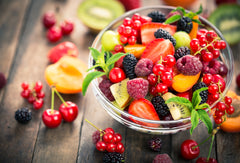Which Fruit is Good for Piles? Discover the Top Fruits to Eat for Hemorroids
Posted on 14 October 2018 by Maryanne Johnson
Share this post
Want to know which fruit is good for piles? Research conducted collectively by doctors, scientists, and health professionals tells us that a dietary change is most effective in treating piles. If you are wondering which fruit is the best for piles, the answer is, you can’t go wrong.
All fruits have fibre content to them, some more than others. For higher fibre content, go for apples, pears, and berries, especially if they have their skins still.
Just as fruits are filled with fibre, vegetables are the same, and by eating both, you can ensure that you are getting the fibre you need to prevent a case of the piles.
Why Fibre is Essential to Piles Prevention
Most people do not get enough fibre, which is why constipation and straining on the toilet is one of the leading causes behind the development of piles.
Piles are a series of veins, intertwined with blood vessels, connecting tissue substances, and arteries and they react to increased pressure by becoming swollen and symptomatic.
Pushing and struggling on the toilet pressurizes these sensitive rectal veins, and hardened stools can sometimes roughly bypass the anal canal, abrasively scraping already inflamed internal haemorrhoids, producing the common symptom of bright red rectal bleeding.
Main causes of piles can include:
- Constipation
- Being overweight
- Any kind of straining on the toilet
- Diarrhea
- Pregnancy
- Not enough fibre in the diet
If you aren’t sure if you are getting enough fibre, think about your toilet habits. Are you regular? What do your stools look like? Healthy bowel movements should produce soft stools with a balance of bulk and moisture.
Everyone is different, so there is no correct amount of bowel movements you must pass to be considered “normal.”
Fruit is one of many excellent sources of fibre. Doctors typically want their patients to seek out fibre in whole foods rather than having to rely on fibre supplements for their daily intake.
Whole foods are more beneficial overall and provide additional nutrients essential for a healthy and balanced diet.
People with reoccurring piles should initially take a conservative approach to their treatment by making small changes in their diet or lifestyle. Too much at once can be overwhelming and produce adverse effects on the body.
While exercise is also handy in piles prevention, it needs to be complemented by a healthy, fibrous diet. For people with piles currently, exercise can be a double-edged sword, worsening symptoms or prolonging their presence.
Mild exercises that still increase the heart rate like a brisk walk or jog can increase circulation to the rectal veins, while fibre helps move stools along the digestive tract.
Find Your Fruit
Don’t force yourself to eat foods you don’t like because your new diet to prevent piles won’t stick. It’s simple human psychology to avoid the things we don’t find satisfying, and this explains why so many New Year’s resolutions hardly last a full year.
Instead, try different fruits high in fibre and once you find a meal or particular fruit you enjoy eating, implement it as a part of your daily dietary planning.
Exercise also follows this general rule because if you make yourself engage in activities you don’t find enjoyable, then it is bound to fall through, and quickly.
There are a plethora of varying fruits of shapes, tastes, and sizes that you can find a high content of fibre in. From bananas to strawberries, fruit can range from juicy and citrus-flavored, soft and palatable, or tart with a hint of sweetness.
Fruits that contain around five grams or more of fibre are considered and labeled as “high in fibre.”
If you are looking to eat fruit to prevent piles and encourage healthier toilet habits, you will need a handful of these fruits to meet your fibre requirements:
- Apples
- Pears
- Blackberries
- Raspberries
Plenty of fruits can be found with around two to three grams of fibre:
- Bananas
- Dates
- Figs
- Kiwis
- Plums
- Blueberries
- Oranges
Keeping a food diary can help you track the amount of fibre you consume. Staying vigilant on your fibre content will set you up for success in addressing your piles condition.
Don’t Skip the Peels
Many people love to peel their fruit, and that’s perfectly fine, but if you are after more fibre then consider leaving the peel or skin on and eating it. The skin around the fruit contains even more beneficial fibre that is necessary for your diet.
The more vibrant the colors, the better the peels are to eat. Apples wrapped in bright greens, dark reds or pretty pink peels are chalk full of needed fibre to help keep your bowels regular, which ultimately will help with your piles.
Various veggies have peels that are an excellent source of insoluble fibre, a type of fibre that aids in the prevention of constipation. If you recall, constipation is often the reason why so many adults develop and experience frequent piles.
Insoluble fibre bulks the stools and moves the waste along more quickly through the digestive tract. Eating fruit is just as important as eating vegetables because each carries the two types of fibre needed for healthy and regular defecation.
Apple peels have soluble fibre, which turns to gel as it is going through the digestive process.
This gel-like substance derived from soluble fibre attracts water and slows digestion, and while this doesn't sound like something that could benefit constipation, it does. More water is being introduced into your stools, making them more passable during bowel movements.
Slow and Steady
Maybe you have not been very good about eating fibre or seeking out whole foods with plentiful amounts of insoluble and soluble fibre. You might come to realize this is most definitely why you have frequent pop-ups of piles, either internal or external piles, or both.
Your reaction to learning that fibre can work tremendously well in both treating and preventing piles might be to eat all the fibrous foods you can get your hands on or perhaps overindulge in a fibre supplement.
If your body is not accustomed to eating the full recommendation of dietary fibre per day, then you could experience some consequences if you consume too much, too quickly.
Too much fibre can lead to:
-Diarrhea
-Abdominal bloating
-Cramping and mild discomfort
-Excess gas
The reaction of someone not used to eating plentiful amounts of fibre is not deadly by any means, just uncomfortable.
For one, you may experience abdominal bloating because your body isn’t in the habit of digesting such large amounts of fibre. Bloating is mildly uncomfortable and will often subside after a day or so.
Excessive flatulence is another common side effect of ingesting too much fibre at once. This too will pass within a day or so, your body just needs to digest the fibre and get it out of its system.
You might experience a bout of diarrhea and a sick feeling within your bowels. Taking too much fibre can interfere with your body’s normal processes, including how it builds and passes stools. If you allow yourself a day or so, you can recover quickly.
Slowly work up to a point where you are meeting all of the advised daily fibre requirements. Keeping a record of the amount of fibre you ingest will help prevent any unwanted and uncomfortable side effects.
Women should get about twenty-five grams a day while men should have fibre intake of about thirty-eight grams a day.
As you fill your plate with your favorite fruits, keep your daily-recommended intake in mind, planning out the rest of your meals to fulfill it.
Fibre is better with water, as staying hydrated pushes food waste along your digestive tract so you can have productive and regular trips to the toilet.
Regardless of your gender or age, everyone should be drinking around eight glasses of water a day, or possibly more if you are exercising vigorously or out in the hot sun.
Your piles may not go away overnight, but with reaching for an extra helping of fruit, you can begin your journey back to health and say goodbye to your piles in a matter of days.
Fibrous fruit will not only help you with your piles but also provide your body with a healthy surplus of other needed nutrients.





0 comments